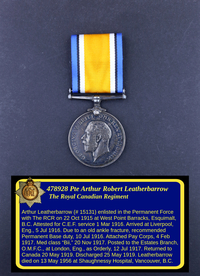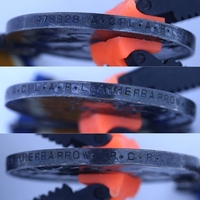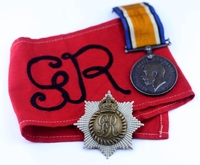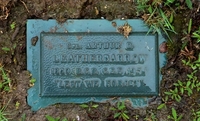
478928 Private Arthur Robert Leatherbarrow
The Royal Canadian Regiment
By: Capt (ret'd) Michael M. O'Leary, CD, The RCR
Arthur Robert Leatherbarrow was born in Liverpool, Lancashire, England, on 22 Sep 1880. he was the son of Charles Frederic and Emma Atwood Leatherbarrow. The family can be found in the 1881 census of England in the rural West Derby district of Lancashire. Charles (33) and Emma (33) are shown with five children; Joseph P. (12), Charles W. (10), Frederick (4), Mary E. (2) and Arthur (less than one year old). Ten years later, on 23 Apr 1891, the family appears in the Canadian census for the Upper Kootenay sub-district of British Columbia. Charles, now a 43-year-old railway car oiler and Emma (43) have two children still at home, Fred A. (15) and Arthur (9).
Leatherbarrow enlisted in the Canadian Permanent Force with The Royal Canadian Regiment on 22 Oct 1915 at a new company station established at West Point Barracks, Esquimalt, B.C. The RCR had garrisoned company stations in central and eastern Canada since the Regiment was formed in 1883. In 1914, at the outbreak of the First World War, Captain Edward Seely-Smith was in British Columbia en route to an exchange posting in Australia. The declaration of war resulted in Seely-Smith being ordered to remain in Canada, and to establish a new company garrison at Esquimalt. This new location, "L" Company, would perform garrison duties and recruit regimental soldiers throughout the First World War. On enlistment in The RCR, Leatherbarrow was given the regimental number 15131.
The RCR had spent the first year of the war, from September, 1914 to August, 1915, executing garrison duties in Bermuda. The Regiment returned to Halifax for a stay of only a week during which, the soldiers were re-attested for overseas service. Although The RCR had just spent a year in Bermuda, there were concerns regarding the applicability of the soldiers' Permanent Force enlistments for wartime deployments. This was, perhaps, prompted by the idea that a man on a P.F. three-year engagement could choose not to re-engage and the Government would be obligated to bring him home. Enlistment in the C.E.F., on the other hand, was for the "Duration of War." Accordingly, the soldiers of The RCR were re-attested, signing C.E.F. attestation papers in August 1915 before sailing for Europe. One result of this process was that later enlistments into the Regiment as Permanent Force soldiers still had to complete attestations to serve in the C.E.F. if they volunteered to proceed overseas.
Leatherbarrow attested for overseas service in the Canadian Expeditionary Force (C.E.F.) with The RCR at Esquimalt, B.C. on 1 Mar 1916. A 35-year-old waiter, Leatherbarrow was described on his attestation paper as 5 feet 4 inches tall, weighing 120 pounds, with a 33 1/2-inch chest, a fair complexion, blue eyes, and brown hair. His religious denomination was Church of England. Leatherbarrow identified his mother, Mrs. A.E. McKinnon, as his next of kin. On attesting for the C.E.F., Leatherbarrow was given the service number 478928 from a number block allocated to the Regiment for C.E.F. enlistments.
On 12 May 1916, Leatherbarrow was transferred from "L" Company, Esquimalt, to the Base Depot of The RCR at Halifax. Six weeks later, on 28 Jun 1916, he would embark for England aboard the S.S. Olympic. On sailing, Leatherbarrow was transferred to the Base Depot at Shornecliffe.
The Olympic arrived at Liverpool, Eng., on 5 Jul 1916 and Leatherbarrow was taken on the strength of The R.C.R. & P.P.C.L.I. Depot at East Sandling, a short-lived depot unit that supported those two named regiments with drafts of reinforcements. The Depot was created on 13 Feb 1916 by separating it from the 11th Reserve Battalion, and it was disbanded on 20 Jan 1917 when it was absorbed into the 7th and 26th Reserve Battalions.
Once in England, Leatherbarrow's fitness for service in France and Flanders came into question. He was examined by a Medical Board at Caesar's Camp on 10 Jul 1916. The Board's recommendation, based on an old ankle fracture, was that he remain on Permanent Base duty.
Leatherbarrow was struck off the strength of The R.C.R. & P.P.C.L.I. Depot on 15 Jul 1917 and transferred to the Canadian Casualty Assembly Centre (C.C.A.C.), where wounded and others with medical fitness issues were assessed for either further treatment or return to duty. From the C.C.A.C. he was reattached to the Depot and shown "On Command," i.e., a temporary duty assignment. This move effectively changed his parent unit but not his location or employment.
On 1 Jan 1917, as The R.C.R. & P.P.C.L.I. Depot, Leatherbarrow was transferred to the 7th Reserve Battalion. One month later, on 4 Feb 1917, he was attached to Canadian Army Pay Corps (C.A.P.C.). Leatherbarrow's parent unit changed from the 7th Res. Bn. to the Eastern Ontario Regimental Depot (E.O.R.D.) on 13 Feb 1917. Despite this change, he was attached once more to the 7th Reserve Battalion on 1 Mar 1917 and sent On Command to Headquarters Seaford for duty and under the Canadian Army Service Corps (C.A.S.C.) at that location for rations.
Leatherbarrow rapidly changing status of parent unit and employment continued to change on 4 Apr 1917 when he was taken on the strength of the 7th Res. Bn. Two weeks later, on 17 Apr 1917, he ceased to be On Command at H.Q. Seaford.
On 2 Jun 1917, Leatherbarrow was granted permission to marry. The same month, he established a monthly Pay Assignment of $20 to be sent to his wife. As a Private in the C.E.F., Leatherbarrow was paid $1.00 per day plus an additional ten cents daily field allowance. His pay assignment represented about two-thirds of his monthly pay.
The next month, on 12 Jul 1917, Leatherbarrow was posted to the Estates Branch, Overseas Military Forces of Canada (O.M.F.C.), at London, England, and attached as Orderly. Employed at the Estates Branch, he found some stability. On 22 Oct 1917, Leatherbarrow was entitled to wear one Good Conduct Badge. A few days later, on 25 Oct 1917, he was appointed Clerk, Class 2, back-dated to 17 Oct 1917.
Starting in November 1917, Leatherbarrow was entitled to monthly Separation Allowance to be sent to his wife. The address recorded for Mrs. Ethel L. Leatherbarrow was 34 Duncan Terrace, City Rd., Islington, London, W. The allowance was initially $20 per month, and increased to $25 in December, 1917. Separation Allowances increased again in September, 1918, to $30 per month.
In November, 1917, Leatherbarrow had his only period of hospitalization during the war. He was hospitalized with scabies at the Holborn Military Hospital, Western Road, Mitcham, from 2 to 7 Nov 1917. His case notes read:
"2 Nov 1917: Transferred from Canadian Estates Office where he has been five months. Says he has no itching but there are a few isolated suspicious spots on hands and penis which have been two days. Slights soft soap and Kerol baths and light. [Slight's and Kerol were brand named products.] Calcis sulphur for three days. To say in bed three days.
"4 Nov 1917; To get up, discontinue sulpher.
"5 Nov 1917; No V.D. Recommended for discharge."
The limitation created by his foot, however, continued. On 20 Nov 1917, a Medical Board at London, Eng., classified Leatherbarrow as "Bii" on 20 Nov 1917. This category was for men who were fit for base units of the medical service, garrison, or regimental outdoor duty The cause of this classification was noted as "fracture right ankle" and it was "not likely to be raised."
Although Leatherbarrow had married in June, and he was sent to work in London in July, it was not until December, 1917, that he was granted leave. He went on leave from 20 to 26 Dec 1917. At the time, his wife's address was 34 Duncan Terrace, Islington, London, W. In January, 1918, Ethel Leatherbarrow moved to 118 Hindes Rd., Harrow-on-the-Hill. She moved again in April, 1918, to 209 Kingsland Rd., London.
On 25 Feb 1918, Leatherbarrow was appointed Clerk, Class 1. That summer, he went on leave again from 2 to 8 Jul 1918.
Leatherbarrow was promoted Acting Corporal on 12 Feb 1919. This promotion came with pay and allowances of rank whilst employed in Estates Branch, O.M.F.C. The following month he went on his third period of leave since arriving in England, from 24 to 31 Mar 1919.
Examined by a Medical Board at 3 Southampton St. on 19 Mar 1918, the limitations on Leatherbarrow's employment because of the deformity of his right foot was confirmed. A Medical History of an Invalid form completed on him at this time noted that the fractured right ankle that kept him from going to France was suffered in Hong Kong in 1897. The details noted were:
"Patient states that he fractured his right ankle when seventeen years of age, but that it gives him no trouble now except that he wears the outer sole of boot out quickly; that he feels quite fit. External Malleolus enlarged, foot everted. Patient is rather poorly nourished. Weight on enlistment 120 pounds, present weight 110 pounds."
The Board concurred that Leatherbarrow was fit for service, but not "general service." Other than the condition of his foot, Leatherbarrow was found to be in good health. He was again given the medical category "Bii" and it was recommended that he be boarded for return to Canada.
The form completed for the Board also noted Leatherbarrow's tattoos. These were a beaver on his left forearm and a crown and anchor on his right forearm.
Leatherbarrow was struck off the strength of the Estates Branch, London, on 5 Apr 1919 and taken on the strength of the General Depot on proceeding to Buxton Discharge Depot for return to Canada. Five days later he ceased On Command 1 C.D.D. Buxton and was struck off the strength of the General Depot to the C.E.F. in Canada. Boarding the S.S. Scandinavian, which sailed on 10 May 1919, Leatherbarrow was taken on the strength of the Quebec Depot Clearing Services Command.
Disembarking at Quebec on 20 May 1919, Leatherbarrow was taken on the strength of the Quebec Depot Clearing Services Command and rapidly through the discharge process. On 25 May 1919, Leatherbarrow was discharged from the C.E.F. on demobilization. His Proceeding on Discharge form recorded the information that his trade was "poultry farmer," with "waiter" struck through.
On discharge, Leatherbarrow was eligible to receive a War Service Gratuity of $420. Ethel also received a spousal amount of $180. Cheques were issued to both of them in five installments between June and October 1919. The address recorded for both Arthur and Ethel in June 1919 was G.P.O. Vancouver, B.C. (Ethel has not been found in available records after this, She does not appear in the B.C. Archives records for deaths in the province.)
For his service in the C.E.F., Leatherbarrow was entitled to receive only the British War Medal because his service overseas was only in the United Kingdom. His medal was despatched to him at General Delivery, Victoria, B.C., on 21 Jul 1921.
Leatherbarrow appears in the 1938 List of Electors (Voters List) for the District of Vancouver North, Rural Polling Division No. 18 Port Moody. In 1938 he is shown to be living alone, recorded as "Leatherbarrow, Arthur, fisherman, Pleasantside." In the 1953 voters list, Leatherbarrow was still living in Pleasantside, and he is recorded as "retired."
Arthur Leatherbarrow died on 13 May 1956 at Shaughnessy Hospital, Vancouver, B.C. The cause of death was bile duct carcinoma with bi-lateral broncho-pheumonia. This was not considered a result of his service. Leatherbarrow's next of kin recorded at the time of his death was his friend, Mrs. Gilding, 2530 Royal Oak Ave., Burnaby, B.C. which was also Leatherbarrow's home address at the time. Leatherbarrow's remains were cremated and interred at Mountain View Cemetery, Vancouver, B.C. The small marker on his grave reads: "Cpl. Arthur R. Leatherbarrow, 1860-1956, R.C.R. C.E.F., "Lest We Forget."
Pro Patria
Visit a randomly selected page in The O'Leary Collection (or reload for another choice):
- The O'Leary Collection; Medals of The Royal Canadian Regiment.
- Researching Canadian Soldiers of the First World War
- Researching The Royal Canadian Regiment
- The RCR in the First World War
- Badges of The RCR
- The Senior Subaltern
- The Minute Book (blog)
- Rogue Papers
- Tactical Primers
- The Regimental Library
- Battle Honours
- Perpetuation of the CEF
- A Miscellany
- Quotes
- The Frontenac Times
- Site Map
QUICK LINKS
The O'Leary Collection—Medals of The Royal Canadian Regiment
Newest additions:
![]()
![]() SB-12725 Private Henry "Hank" Ard
SB-12725 Private Henry "Hank" Ard ![]()
WIA at Hill 187, Died of Wounds in Japan
![]()
![]() 2355331 Lance Corporal Albert Lorking
2355331 Lance Corporal Albert Lorking
Wounded in action, later a War Amps representative.
![]()
![]() 4334 / 477996 Pte Isaac Hamilton Wilcox
4334 / 477996 Pte Isaac Hamilton Wilcox
Permanent Force, South Africa, and C.E.F.
![]()
![]() 477019 Private Harold Ashcroft
477019 Private Harold Ashcroft
Transferred to the Tunnelers.
![]()
![]() 734231 Private Clark D. Thompson
734231 Private Clark D. Thompson ![]()
The older Thompson brother, killed in action.
![]()
![]() 733849 Private Norman Parker Thompson
733849 Private Norman Parker Thompson
The younger Thompson brother; post-war service in the Special Guard.
![]()
![]()
![]() A305 / 400305 Private Andrew Walker
A305 / 400305 Private Andrew Walker ![]()
"Previously reported Wounded, now Killed in Action."
![]()
![]() 823298 Pte Thomas Patrick Steele, M.M.
823298 Pte Thomas Patrick Steele, M.M. ![]()
… for gallant conduct in the field …
![]()
![]() P13066 Sergeant Harold Thompson
P13066 Sergeant Harold Thompson
Instrumental Soloist for over 20 years of Canadian Army service.
![]()
![]() 9609 / 477728 Private Albert Edward Piper
9609 / 477728 Private Albert Edward Piper
"Arrived from England as a STOWAWAY …"






